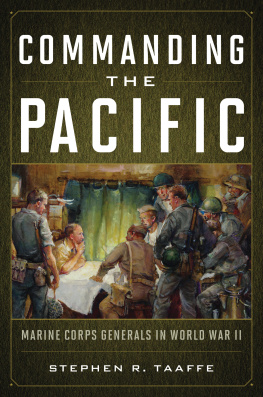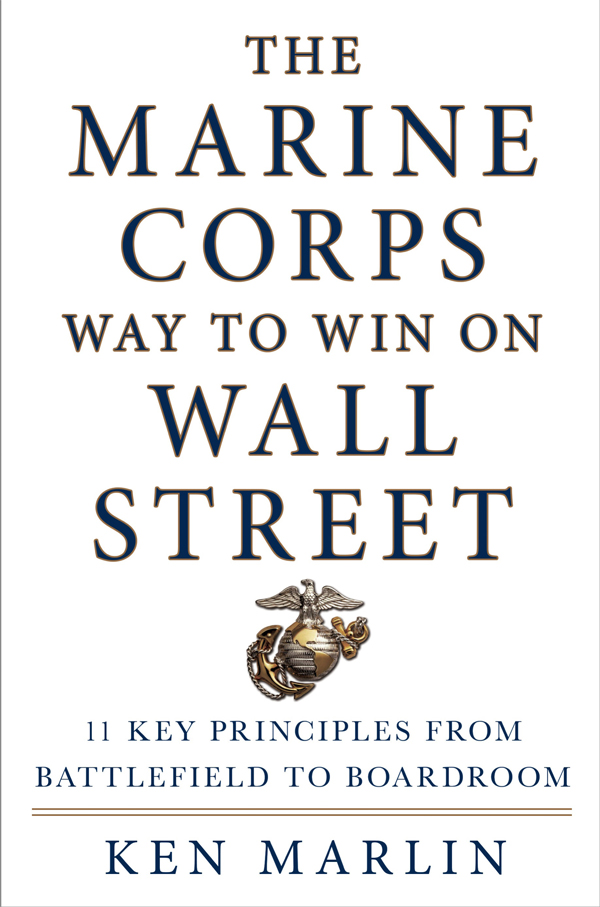Contents
Guide

The author and publisher have provided this e-book to you for your personal use only. You may not make this e-book publicly available in any way. Copyright infringement is against the law. If you believe the copy of this e-book you are reading infringes on the authors copyright, please notify the publisher at: us.macmillanusa.com/piracy.
This book is dedicated to:
Colonel Chuck Barstow, Colonel Joe OBrienand all the other leaders who showed me by example what the Marine Corps Way really is.
Captains Paul Pugh, Greg Von Wald, Chris Covert, and Jim McClainmy fellow company commanderswho showed me every day how it should be done in the field.
Bob Weissman, Dick Schmidt, Dave McBride, Bill Jacobi, Tom Wendel, and others who encouraged me to apply the Marine Corps Way to leading Main Street companies.
John Suhler and John Veronis, who first allowed me to apply the Marine Corps Way on Wall Street.
And Max, Paul, and Jasonwho have been with me for the journeystill areand who help me implement the Marine Corps Way every day.
In late 1985, the chairman and CEO of Dun & Bradstreet, Charles Moritz (Charlie to his friends; Mr. Moritz to me), summoned me to his office. I had been working for D&B for a little over four years, having joined the company after serving for a decade in the US Marines. I had never before been summoned specifically to see Mr. Moritz, and I had no idea what he wanted to talk about. I wouldnt call the scene intimidating; Im not easily intimidated. But it was unusual and I was curious.
In those days, the D&B corporate headquarters, of which I was a part, operated largely as the center of a sector-focused private equity firm. It bought portfolio companies, supported the heads of those companies financially, provided capital, ensured that financial reporting was done well, and encouraged growth through acquisitions that could be tucked under their umbrella where they could share expenses and perhaps find some product or revenue synergies. As in many PE firms, D&B would subject budgets, acquisitions, and expansion plans to a thorough review, even selling companies when they were deemed to no longer fit the corporate strategy or were performing below D&Bs standards. D&B then owned something like twenty-three different major businesses worldwide, each of which operated independently, and most of which had absolutely nothing to do with each other. They included Moodys Investors Service, Interactive Data Corporation, Reuben H. Donnelley, Donnelly Marketing, McCormack & Dodge, AC Nielsen, and the Dun & Bradstreet credit information business for which D&B is now best known.
D&B had been around for more than 140 years when I joined. It was a highly respected brand, and I was happy to be there. The chairman and CEO then was Harrington Duke Drake, a super salesman who had worked his way up through the Reuben H. Donnelley Corporation (a big marketing services firm best known as a publisher of classified phone directories) to become the head of that firmand then, after it merged with D&B, to become our CEO. When I joined, Duke was in the midst of putting his imprint on the company. Over the next few years D&B invested billions of dollars in thirty-three major acquisitions and dozens of other smaller ones.
Moritz had been Dukes protg. Both had attended elite private East Coast colleges (Yale for Moritz; Colgate for Drake); and both had come up similar routes through sales and then executive leadership.
Moritz certainly looked the part of the top New York executive. The New York Times had captured his essence in a piece announcing his ascension to CEO, describing him as personifying the conservative businessman:
He lives in Darien, Conn., hes 48 years old, and he has three children. He plays golf and reads spy novels. His neatly trimmed hair is gray; his suit, pinstriped; and his reading glasses, half frames that sit on the edge of his nose.
The last time I had been in a room with Moritz, he had rejected a proposed acquisition. In the past, the target company had been accused of paying bribes to local government officials. He wanted no risk to D&Bs reputation. We had discussed this companys questionable past internally before bringing the deal to Moritz, and we had flagged the issue as a potential risk. The executive vice president (EVP) sponsoring the deal had concluded that the company fit his strategy, the price was right, the company had learned from its mistake, and that we could neutralize the potential fallout by bringing them into our culture and values. The EVP believed the risk of the companys repeating the bad behavior was low. But Moritz just hadnt been willing to take the risk; it wasnt just about potential damage to the one company, but about potential reputational risk to the other trusted D&B brands. In his view, if one D&B firm was caught in a scandal, it could tarnish others, including our flagship business-information company and Moodys, our bond-rating agencyand that could be expensive. Even though I was on the team advocating the acquisition, I respected Moritzs decision. It made sense; and I respect executives who assess a situation and take a stand, rather than deliberate forever.
Afterward, however, I overheard the EVP who had championed the deal screaming at one of his subordinates. He was worried that its demise would be a blemish on his career. Why had she let him take a deal to the chairman that would be turned down?! (As if it were her decision.) How could she have put him in this position? (As if he had no responsibility.) There was even talk of people losing their jobs. I didnt get it. We had done our homework, identified the opportunity as well as the threat (reputational risk), come up with a plan to neutralize it, and run the plan up the chain. The deal was a nice-to-havenot critical to D&Bs long-term strategic missionand we may well have avoided a later problem. (A few years later, the firm was indeed involved in another bribery scandal.)
The panic in that executives voice was, for me, odd to hear from a leader. Marines take particular pride in how they handle adversity. Our whole institutional identity is wrapped up in the notion that you dont panic when things dont go as planned; you just push forward and calmly find another way to achieve the objective. No drama. Further, one of the first leadership principles Marines are taught is to take responsibility for your actions. Own it. Blaming subordinates for a decision you made is about the quickest way to signal panicand lose the respect of those subordinates.
The EVP described above was smart. He had an MBA from a top school; hed been a management consultant at a top firm; and he had risen quickly within D&B. He was analytical and cerebral and had some pretty good ideasnotwithstanding the latest debacle. But he also was a caricature of a political manager with no clue how to lead, symptomatic of what to me at the time felt like an obvious disjuncture between the world Id known in the Marines and that world I was now occupyinga world in which an individuals compensation and place of power in a hierarchy is enhanced by who your parents are, where you went to school, where you live, and who your friends are; and harmed by perceived judgmental failures (witness the failed attempted acquisition). On the rare occasion that success is measured by any objective criterion, the standard is likely to be the individuals achieving some short-term objective, without regard to the organizations long-term goals.












